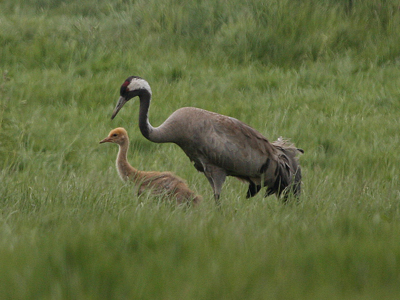
By Hywel Maggs, Conservation Officer, North East Scotland, Royal Society for the Protection of Birds
Old written records, artifacts and place names indicate our ancestors’ familiarity with cranes, but definitive evidence of historical breeding in Scotland it is hard to come by. However, it seems inconceivable that cranes did not breed in many parts of Scotland up until at least some time in the Middle Ages.
We have anticipated the re-colonization of Scotland by breeding Eurasian Cranes for some years now. The pattern of movement and breeding colonization by cranes across north-west Europe over the past two decades indicated, in our calculation, that occupation of Scottish breeding sites was pretty much inevitable. The re-colonization of the United Kingdom (UK) began in England during the late 1970s in Norfolk. Since the 1990s numbers have increased and new English sites have been colonized. In 2012, the UK population stood at 22 pairs.
A pair was suspected to have unsuccessfully bred in Caithness, Scotland in 1997, but this did not result in long-term re-colonisation. In 2012, breeding was confirmed in North East Scotland, and it is likely that there had been previous breeding attempts at the same site in earlier years. This is the first confirmed breeding in Scotland in modern times, with a single chick fledging in 2012 and 2013 (upper right).
Cranes are extremely susceptible to disturbance, to the extent that this could jeopardize the whole re-colonization process. To help ensure this does not happen, the site location is being kept confidential. There is currently no sanction available within current Scottish legislation to effectively prevent disturbance of this species. Addition to Schedule 1 to the Wildlife and Countryside Act 1981 would provide such a sanction. The Royal Society for the Protection of Birds (RSPB) Scotland has been coordinating monitoring of breeding activity and any disturbance through a Crane Conservation Group, made up of a small group of RSPB staff, volunteers and local landowners.
The local community are aware of the birds’ presence, understand the disturbance issue and are generally supportive of actions to protect the cranes. The mixed farming system in the area appears to be benefitting the cranes. We would like to thank all the farmers who are helping the cranes gain a breeding foothold in Scotland.
